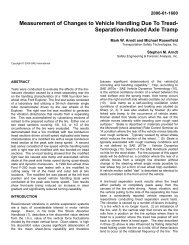Vehicle Handling with Tire Tread Separation - Transportation Safety
Vehicle Handling with Tire Tread Separation - Transportation Safety
Vehicle Handling with Tire Tread Separation - Transportation Safety
You also want an ePaper? Increase the reach of your titles
YUMPU automatically turns print PDFs into web optimized ePapers that Google loves.
DISCUSSION - CIRCLE TURN TEST RESULTSThe circle turn maneuver was performed <strong>with</strong> fourunmodified tires, 3 unmodified tires <strong>with</strong> a modified tireon the left rear and 3 unmodified tires <strong>with</strong> a modified tireon the left front. Turns were made both towards (left) andaway (right) from the side <strong>with</strong> the modified tire.FOUR UNMODIFIED TIRESThe Bronco II equipped <strong>with</strong> four unmodified tires understeeredthroughout the circle turn test. In the limit, thefront axle saturated prior to the rear and the vehicle“plowed out.” These observations were noted for bothright and left circle turns. The maximum lateral accelerationachieved was approximately 0.74 g and 0.78 g for theright and left circle turns respectively. As can be seen inthe Figures 3 and 4, the Bronco II understeer gradientincreased as the maximum lateral acceleration wasachieved.MODIFIED TIRE AT LEFT REAR POSITIONFigure 3. Left Circle Turn ResultsAnalysis of the circle turn data was performed using thesteering wheel angle and lateral acceleration data to plotthe oversteer/understeer characteristics for the vehicle ineach test configuration.When a modified tire was placed on the left rear wheelposition and the circle turn was conducted to the right,the difference in behavior was dramatic. Figure 4 showsthat the vehicle understeered slightly until a lateral accelerationof approximately 0.3 G was attained. The vehiclethen began to oversteer at an increasing rate. The maximumlateral acceleration achieved during this test wasapproximately 0.6 G.When the test was run to the left, the vehicle behavedsimilarly to the vehicle <strong>with</strong> four unmodified tires. Thevehicle did not understeer as much, but was able toachieve a maximum lateral acceleration of 0.74 G whichwas only slightly less than the 0.78 G achieved <strong>with</strong> fourunmodified tires. <strong>Vehicle</strong> understeer increased as the lateralacceleration increased. The test was terminatedwhen the vehicle velocity could not be increased due toinside rear wheel spin. Neither vehicle was equipped <strong>with</strong>a limited slip type rear differential.MODIFIED TIRE AT LEFT FRONT POSITIONFigure 4. Right Circle Turn ResultsThe steering wheel angle data was first normalized bydividing by the steering box gear ratio of the Bronco II.Both data sets were then filtered using a 100 point movingaverage. The combined data set (steer angle v. lateralacceleration) was then curve fitted <strong>with</strong> a fifth order polynomialand plotted in Figures 3 and 4.A circle turn test to the right <strong>with</strong> the modified tire on theleft front wheel position resulted in the Bronco II understeeringsubstantially more when compared to the fourunmodified tire configuration. The maximum lateral accelerationachieved during this test was approximately 0.55G. This was a reduction in the lateral acceleration ofapproximately 0.19 G. The test was terminated when thefront end of the vehicle began to plow out.When the test was repeated to the left, the vehiclebehaved similarly to the vehicle <strong>with</strong> four unmodifiedtires. The understeer was slightly greater than <strong>with</strong> fourunmodified tires and the maximum lateral accelerationachieved was slightly less at approximately 0.72 G ascompared to 0.78 G. For the Bronco II at the lateralacceleration limit, the inboard front wheel typically liftedoff of the ground thus effectively eliminating the contributionof the modified tire. This test was terminated whenthe vehicle could no longer be driven on the circle due tofront axle saturation4




